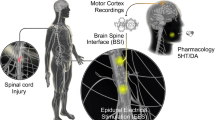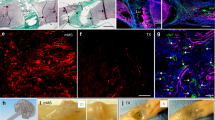Abstract
The goal of this study was to develop stable intraspinal microstimulation (ISMS) implants for use in humans to restore standing and walking after spinal cord injury. ISMS electrically activates locomotor networks within the lumbar region of the spinal cord. In animals, ISMS produced better functional outcomes than those obtained by other interventions, and recent efforts have focused on translating this approach to humans. This study used domestic pigs to: (1) quantify the movements and length changes of the implant region of the spinal cord during spine flexion and extension movements; and (2) measure the forces leading to the dislodgement of the ISMS electrodes. The displacement of the spinal cord implant region was 5.66 ± 0.57 mm relative to the implant fixation point on the spine. The overall length change of the spinal cord implant region was 5.64 ± 0.59 mm. The electrode dislodgment forces were 60.9 ± 35.5 mN. Based on these results, six different coil types were fabricated and their strain relief capacity assessed. When interposed between the electrodes and the stimulator, five coil types successfully prevented the dislodgement of the electrodes. The results of this study will guide the design of mechanically stable ISMS implants for ultimate human use.








Similar content being viewed by others
Abbreviations
- FES:
-
Functional electrical stimulation
- FBR:
-
Foreign body response
- ISMS:
-
Intraspinal microstimulation
- SCI:
-
Spinal cord injury
References
Bamford, J. A., R. M. Lebel, K. Parseyan, and V. K. Mushahwar. The fabrication, implantation and stability of intraspinal microwire arrays in the spinal cord of cat and rat. Trans. Neural Syst. Rehabil. Eng. 2016.
Bamford, J. A., C. T. Putman, and V. K. Mushahwar. Intraspinal microstimulation preferentially recruits fatigue-resistant muscle fibres and generates gradual force in rat. J. Physiol. 569:873–884, 2005.
Bamford, J. A., K. G. Todd, and V. K. Mushahwar. The effects of intraspinal microstimulation on spinal cord tissue in the rat. Biomaterials 31:5552–5563, 2010.
Biran, R., D. C. Martin, and P. A. Tresco. The brain tissue response to implanted silicon microelectrode arrays is increased when the device is tethered to the skull. J. Biomed. Mater. Res. A 82:169–178, 2007.
Busscher, I., J. J. W. Ploegmakers, G. J. Verkerke, and A. G. Veldhuizen. Comparative anatomical dimensions of the complete human and porcine spine. Eur. Spine J. 19:1104–1114, 2010.
Cheng, C., J. Kmech, V. K. Mushahwar, and A. L. Elias. Development of surrogate spinal cords for the evaluation of electrode arrays used in intraspinal implants. IEEE Trans. Biomed. Eng. 60:1667–1676, 2013.
Dennison, C. R., P. M. Wild, D. R. Wilson, and P. A. Cripton. A minimally invasive in-fiber Bragg grating sensor for intervertebral disc pressure measurements. Meas. Sci. Technol. 19:085201, 2008.
Dennison, C. R., P. M. Wild, D. R. Wilson, and M. K. Gilbart. An in-fiber Bragg grating sensor for contact force and stress measurements in articular joints. Meas. Sci. Technol. 21:115803, 2010.
Ersen, A., S. Elkabes, D. S. Freedman, and M. Sahin. Chronic tissue response to untethered microelectrode implants in the rat brain and spinal cord. J. Neural Eng. 12:016019, 2015.
Hachmann, J. T., J. H. Jeong, P. J. Grahn, G. W. Mallory, L. Q. Evertz, A. J. Bieber, D. A. Lobel, K. E. Bennet, K. H. Lee, and J. L. Lujan. Large animal model for development of functional restoration paradigms using epidural and intraspinal stimulation. Plos One 8:e81443, 2013.
Harrison, D. E., R. Cailliet, D. D. Harrison, S. J. Troyanovich, and S. O. Harrison. A review of biomechanics of the central nervous system–part II: spinal cord strains from postural loads. J. Manip. Physiol. Ther. 22:322–332, 1999.
Holinski, B. J. Restoring walking after spinal cord injury. 2013. <https://era.library.ualberta.ca/public/view/item/uuid:0e698e79-b16a-4519-baf7-552a49dda767/>.
Kim, T., A. Branner, T. Gulati, and S. F. Giszter. Braided multi-electrode probes: mechanical compliance characteristics and recordings from spinal cords. J. Neural Eng. 10:045001, 2013.
Kipke, D. R., R. J. Vetter, J. C. Williams, and J. F. Hetke. Silicon-substrate intracortical microelectrode arrays for long-term recording of neuronal spike activity in cerebral cortex. IEEE Trans. Neural Syst. Rehabil. Eng. Publ. IEEE Eng. Med. Biol. Soc. 11:151–155, 2003.
Krompecher, T. Experimental evaluation of rigor mortis V. Effect of various temperatures on the evolution of rigor mortis. Forensic Sci. Int. 17:19–26, 1981.
Lau, B., L. Guevremont, and V. K. Mushahwar. Strategies for generating prolonged functional standing using intramuscular stimulation or intraspinal microstimulation. IEEE Trans. Neural Syst. Rehabil. Eng. Publ. IEEE Eng. Med. Biol. Soc. 15:273–285, 2007.
Louis, R. Vertebroradicular and vertebromedullar dynamics. Anat. Clin. 3:1–11, 1981.
McConnell, G. C., H. D. Rees, A. I. Levey, C. A. Gutekunst, R. E. Gross, and R. V. Bellamkonda. Implanted neural electrodes cause chronic, local inflammation that is correlated with local neurodegeneration. J. Neural Eng. 6:056003, 2009.
Moxon, K. A., S. C. Leiser, G. A. Gerhardt, K. A. Barbee, and J. K. Chapin. Ceramic-based multisite electrode arrays for chronic single-neuron recording. IEEE Trans. Biomed. Eng. 51:647–656, 2004.
Mushahwar, V. K., D. F. Collins, and A. Prochazka. Spinal cord microstimulation generates functional limb movements in chronically implanted cats. Exp. Neurol. 163:422–429, 2000.
Mushahwar, V. K., and K. W. Horch. Selective activation of muscle groups in the feline hindlimb through electrical microstimulation of the ventral lumbo-sacral spinal cord. IEEE Trans. Rehabil. Eng. 8:11–21, 2000.
Nashold, B. S., H. Friedman, J. F. Glenn, J. H. Grimes, W. F. Barry, and R. Avery. Electromicturition in paraplegia. Implantation of a spinal neuroprosthesis. Arch. Surg. Chic. Ill 1960 104:195–202, 1972.
Nashold, B. S., J. Grimes, H. Friedman, J. Semans, and R. Avery. Electrical stimulation of the conus medullaris in the paraplegic. A 5-year review. Appl. Neurophysiol. 40:192–207, 1977.
Oxland, T. R., R. M. Lin, and M. M. Panjabi. Three-dimensional mechanical properties of the thoracolumbar junction. J. Orthop. Res. Off. Publ. Orthop. Res. Soc. 10:573–580, 1992.
Ozawa, H., T. Matsumoto, T. Ohashi, M. Sato, and S. Kokubun. Mechanical properties and function of the spinal pia mater. J. Neurosurg. Spine 1:122–127, 2004.
Peckham, P. H., and J. S. Knutson. Functional electrical stimulation for neuromuscular applications. Annu. Rev. Biomed. Eng. 7:327–360, 2005.
Purves, D., G. J. Augustine, D. Fitzpatrick, L. C. Katz, A. S. LaMantia, J. O. McNamara, and S. M. Williams. The external anatomy of the spinal cord. In: Neuroscience. Sunderland: Sinauer Associates, 2001. <http://www.ncbi.nlm.nih.gov/books/NBK11160/>
Rousche, P. J., and R. A. Normann. Chronic recording capability of the Utah intracortical electrode array in cat sensory cortex. J. Neurosci. Methods 82:1–15, 1998.
Saigal, R., C. Renzi, and V. K. Mushahwar. Intraspinal microstimulation generates functional movements after spinal-cord injury. IEEE Trans. Neural Syst. Rehabil. Eng. 12:430–440, 2004.
Sheng, S. R., X. Y. Wang, H. Z. Xu, G. Q. Zhu, and Y. F. Zhou. Anatomy of large animal spines and its comparison to the human spine: a systematic review. Eur. Spine J. 19:46–56, 2010.
Smit, T. H. The use of a quadruped as an in vivo model for the study of the spine—biomechanical considerations. Eur. Spine J. 11:137–144, 2002.
Smith, J. O. Physical Audio Signal Processing. New York: W3K Publishing, 2010.
Snow, S., S. C. Jacobsen, D. L. Wells, and K. W. Horch. Microfabricated cylindrical multielectrodes for neural stimulation. IEEE Trans. Biomed. Eng. 53:320–326, 2006.
Szentkuti, L., and J. Bruns. Motoneurons of M. semitendinosus in domestic and wild pigs. A horseradish peroxidase and cord-survey study. Anat. Embryol. (Berl.) 167:213–228, 1983.
Ward, M. P., P. Rajdev, C. Ellison, and P. P. Irazoqui. Toward a comparison of microelectrodes for acute and chronic recordings. Brain Res. 1282:183–200, 2009.
White, A. A., and M. Panjabi. Clinical Biomechanics of the Spine. Philadelphia: Wolters Kluwer, p. 722, 1990.
WHO Spinal cord injury. <http://www.who.int/mediacentre/factsheets/fs384/en/>
Wilke, H. J., J. Geppert, and A. Kienle. Biomechanical in vitro evaluation of the complete porcine spine in comparison with data of the human spine. Eur. Spine J. 20:1859–1868, 2011.
Zhong, Y., and R. V. Bellamkonda. Dexamethasone-coated neural probes elicit attenuated inflammatory response and neuronal loss compared to uncoated neural probes. Brain Res. 1148:15–27, 2007.
Acknowledgments
The authors thank Mr. Robert Butz for assistance with early measurement of electrode dislodgement forces, and Mr. Theodore Ng and Dr. Anastasia Elias for assistance in preparing surrogate spinal cords. Funding for this work was provided by the Canadian Institutes of Health Research, the Natural Sciences and Engineering Research Council of Canada and Alberta Innovates – Health Solutions (AIHS). AT was supported by a Vanier Canada Graduate Scholarship and an AIHS Graduate Studentship. VKM was an Alberta Heritage Foundation for Medical Research Senior Scholar.
Author information
Authors and Affiliations
Corresponding author
Additional information
Associate Editor Xiaoxiang Zheng oversaw the review of this article.
Rights and permissions
About this article
Cite this article
Toossi, A., Everaert, D.G., Azar, A. et al. Mechanically Stable Intraspinal Microstimulation Implants for Human Translation. Ann Biomed Eng 45, 681–694 (2017). https://doi.org/10.1007/s10439-016-1709-0
Received:
Accepted:
Published:
Issue Date:
DOI: https://doi.org/10.1007/s10439-016-1709-0




